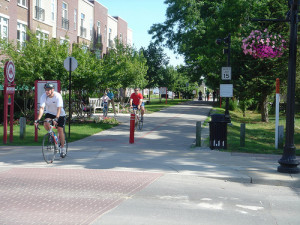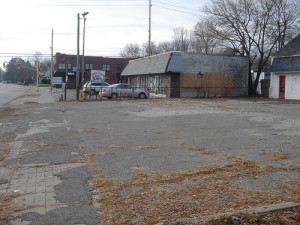[Since it's winter and snow clearance has been in the news lately, I thought it was a good time to rerun this piece looking at the different expectations people in different cities have for public services, and how regardless of where you fall on that, everybody's feeling the pain right now.] Photo Credit: flickr/meryddidanJanuary 1979 saw one of the worst blizzards in city history hit Chicago, dumping 20 inches of snow, closing O'Hare airport for 46 hours, and paralyzing traffic in the city for days. Despite the record snowfall, the … [Read more...]
Rebranding Columbus
It's no secret I'm a fan of Columbus, Ohio, one of those under the radar cities that's a whole lot better than its external brand image would suggest. That frustrates local civic leaders, who've undertaken a major re-branding effort, as discussed in a recent NYT piece, "There May Be ‘No Better Place,’ but There Is a Better Slogan:" Quick, what do you think about when you hear the words “Columbus, Ohio”? Still waiting.... And that’s the problem that civic leaders here hope to solve. This capital city in the middle of a state better known, … [Read more...]
Next American Suburb: Carmel, Indiana
The fate of the suburb is one of the most important issues facing Americas metro areas. While many have decried their environmental unsustainability, even those who don't agree on that should worry greatly about their demographic, economic, and fiscal sustainability. As early inner ring suburbs across America increasingly face decay, poverty, and crime, it is clear that the allure wears off these places once they are no longer shiny and new and people can simply move to another, newer suburb on the fringe that is. If most of today's boomburgs … [Read more...]
People for Urban Progress and the New Grass Roots
I'm starting a new feature on the blog today in which I'll periodically profile great examples of positive urban change coming from the new grass roots. Today I'm featuring People for Urban Progress (PUP) from Indianapolis. One day back when I had an apartment in Indy's Fountain Square neighborhood, I popped into the local bike shop, Joe's Cycles, and saw two people having a conversation with Joe about a project they were working on to make bicycle bags out of reused fabric from the roof of the RCA Dome. I was intrigued and so introduced … [Read more...]
The New Look of the American Suburb
This article is about the intersection of two trends I've written about before: suburban redevelopment and immigration. If you want an easy demonstration of the unsustainability of the classic American suburb, just take a drive around the inner ring suburbs of almost any city, starting with the ones that have a classic branching, winding streets, not traditional grids or those that grew up along transit lines. It is easy to find untold miles of decay, of "dead malls", "grayboxes", and subdivisions that have seen better days. If most of … [Read more...]
True Cities and Shadow Cities
As many cities, particularly smaller industrial ones, continue to struggle with the loss of manufacturing jobs, people wonder how or if these places will come back and again become economically prosperous. I think the potential for economic renewal at least partly depends on whether or not a place is a true city or a shadow city. What do I mean by that? Here is one way I categorize the economic life of cities. One can divide companies into three types: Local goods and services. These are things like banks, grocery stores, dry cleaners, … [Read more...]
Downsides of Consolidation #2 – Cost Increases, Dilution of Urban Interests, Deferred Problems
This is the second and last installment in my mini-series on the downsides of city-county consolidation, or "big box" vs. "small box" government. Part one covers neighborhood redevelopment challenges. For those of you who didn't read that, I'm not opposed to city-county consolidations at all, and generally think they've been positives in places that have pursued them. I am merely examining some of the trade-offs that come with that choice. Like any form of government, this one too has its challenges. Cost Increases Proponents of government … [Read more...]
Downsides of Consolidation #1: Neighborhood Redevelopment
This is the first in a short series of posts on the downsides of city-county consolidation. Actually, it might better be described as a discussion of some of the pros and cons of "big box" vs. "small box" municipal government. It is similar to business. It seems like every large business is either doing one of two things: centralizing or decentralizing. There's a sort of cycle of reincarnation about this. Every model has its flaws, and people tend to gravitate towards the other side of the spectrum from time to time when the problems of the … [Read more...]
An Examination of City-County Consolidation
[ This piece will serve as a warm-up to a forthcoming series on the downsides of the consolidation of US city and county governments. I updated it from the original with a bit of information about the current mayoral election in Louisville. ] H. V. Savitch and Ronald K. Vogel of the University of Louisville authored the paper "Suburbs Without a City", analyzing the merger of Louisville and Jefferson County, and in the process making many good observations about or relevant to other consolidated cities like Indianapolis and … [Read more...]
Mega-Skepticism
[ This post inaugurates a three part series on "megaregions" and the applicability of this concept to the Midwest. It is a repeat of something I wrote on the subject a bit over a year ago. That should lay the ground work. Part two of the series will be a review of the book "Megaregions", edited by Catherine L. Ross. The third part will be some thinking on ways the Midwest might be able to apply megaregional thinking to its problems. As you will see, I come to this subject as a skeptic. This post originally ran on July 11, 2008] There … [Read more...]



